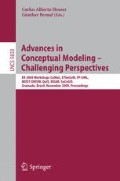Abstract
Representing natural languages with UML has been an important research issue for various reasons. Little work has been done for modeling imperative mood sentences which are the sentence structure of math educational standard statements. In this paper, we propose the MP (Materialization Pattern) model that captures the semantics of English sentences used in math educational standards. The MP model is based on the Reed-Kellogg sentence diagrams and creates MP schemas with the UML notation. The MP model explicitly represents the semantics of the sentences by extracting math concepts and the cognitive process of math concepts from math educational standard statements, and simplifies modeling. This MP model is also developed to be used for aligning math educational standard statements via schema matching.
Access this chapter
Tax calculation will be finalised at checkout
Purchases are for personal use only
Preview
Unable to display preview. Download preview PDF.
References
Booch, G., Rumbaugh, J., Jacobson, I.: The Unified Modeling Language User Guide. Addison-Wesley, Upper Saddle River (2005)
Tseng, F., Chen, C.: Enriching the class diagram concepts to capture natural language semantics for database access. Data & Knowledge Engineering 67, 1–29 (2008)
Ilieva, M.: Graphical notation for natural language and knowledge representation. In: SEKE 2007, pp. 361–367 (2007)
Ilieva, M., Boley, H.: Representing textual requirements as graphical natural language for UML diagram generation. In: SEKE 2008, pp. 478–483 (2008)
Bryan, B., Lee, B.: Two-level Grammar as an Object-Oriented Requirements Specification. In: 35th Hawaii Int. Conf. System Sciences (2002)
Ilieva, M., Ormandjieva, O.: Automatic Transition of Natural Language Software Requirements Specification into Formal Presentation. In: Montoyo, A., Muńoz, R., Métais, E. (eds.) NLDB 2005. LNCS, vol. 3513, pp. 392–397. Springer, Heidelberg (2005)
Bryant, B., Lee, B., Cao, F., Zhao, W., Gray, J., Burt, C.: From Natural Language Requirements to Executable Models of Software Components. In: Monterey Workshop on Software Engineering for Embedded Systems, pp. 51–58 (2003)
Hartman, S., Link, S.: English Sentence Structures and EER Modeling. In: The fourth Asia-Pacific conference on conceptual modeling, pp. 27–35 (2007)
Takahashi, M., Takahashi, S., Fujita, Y.: A development method of UML documents from requirement specifications using NLP. International Journal of Computer Applications in Technology 33(2-3), 164–175 (2008)
Reed, A., Kellogg, B.: Graded Lessons in English (2006) ISBN 1-4142-8639-2
Bloom, B., Krathwohl, D.: Taxonomy of educational objectives: the classification of educational goals by a committee of college and university examiners Handbook 1: Cognitive domain, New York, Longmans (1956)
Author information
Authors and Affiliations
Editor information
Editors and Affiliations
Rights and permissions
Copyright information
© 2009 Springer-Verlag Berlin Heidelberg
About this paper
Cite this paper
Choi, N., Song, IY., An, Y. (2009). The MP (Materialization Pattern) Model for Representing Math Educational Standards. In: Heuser, C.A., Pernul, G. (eds) Advances in Conceptual Modeling - Challenging Perspectives. ER 2009. Lecture Notes in Computer Science, vol 5833. Springer, Berlin, Heidelberg. https://doi.org/10.1007/978-3-642-04947-7_17
Download citation
DOI: https://doi.org/10.1007/978-3-642-04947-7_17
Publisher Name: Springer, Berlin, Heidelberg
Print ISBN: 978-3-642-04946-0
Online ISBN: 978-3-642-04947-7
eBook Packages: Computer ScienceComputer Science (R0)

